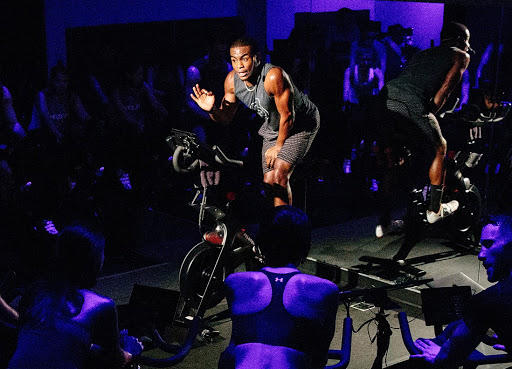Peloton’s mark on the culture of fitness is real. Since 2012, the company has continued to innovate by fusing technology, hardware and programming to create a fitness program that continues to attract athletes of all levels.
This is also thanks in part to an expressive community that has built a reputation for its inclusiveness. It’s a community that even Beyonce is proudly a part of, as the Queen Bee explained during a 2020 partnership announcement: “I’ve been a Peloton member for several years and I’m excited to partner with a company that helps people, young and old, be the best versions of themselves, in an innovative and adaptable way.”
Innovation and adaptation are two things that have propelled the technology brand far beyond the popularity of its signature offering the Peloton bike. Behind the scenes, Alfred Jones, VP, Hardware Engineering, works to bring these products to life.
During a recent sit-down with AfroTech, Jones discussed how Peloton is using technology to change how the industry thinks about fitness and technology — and why it’s important to have different voices guide that process.
Journey to Peloton: Alfred Jones, VP, Hardware Engineering

From cellular to fitness devices, Jones has become well sought for his expertise in product design — the first step in taking a product from ideation to launch — most notably at Lyft, Fitbit and Motorola.
His time at Fitbit would reveal another skill after Jones discovered a new passion for the connected fitness health space. “I was really excited and became very passionate about creating products that change and improve people’s lives,” he says.
At Lyft, he excelled at creating large, complex machinery capable of keeping people connected via the ride-sharing process, with a particular focus on autonomous vehicles. This skill continues to serve him well at Peloton. Since joining the organization, the Morehouse College and NC A&T graduate has transformed his passions into an invaluable skill set that has supported his success as the VP of Hardware Engineering.
“Peloton focuses on improving people’s lives through design and technology, which involves bringing to life complex machinery at scale. And I’d say that’s me in a nutshell; I love combining design and technology. I’m responsible for leading the hardware, mechanical and electrical engineering efforts for Peloton’s Connected Home Fitness products like our Bike and Tread, accessories like our shoes and yoga mats, and a lot of other cool, innovative things.”
Cultivating a Community Through Technology
Peloton has positioned itself as a leader in a previously unseen category by creating a new fitness solution in an increasingly connected world. While Peloton’s bike remains as popular as ever, the tech company’s most popular offering is its community.
Being ahead of the curve in terms of connecting people is something Peloton has done particularly well as the past year of COVID-related isolation showed just how important those connections are.
For Members, it’s the experience itself that sets Peloton apart from the pack. “We’ve created an experience that is exciting and inviting and makes people want to engage and be a part of the Member Community. That’s the difference at Peloton,” Jones explains.
“We also have some really awesome, really inspirational Instructors that have a big impact on people’s lives; that’s part of the ‘secret sauce,’” he continues. “If you’ve ever participated in a Peloton class, you know that it’s life-changing. If you’re having a bad day, you jump into a class with one of our Instructors, and either you turn that frown upside down or you gain the motivation to go harder the next day. I really think that is probably one of the biggest things that we do differently. We care very deeply about our members.”
“If you think we’re the industry leader now, just wait. We’re going to shock, wow and surprise you. We are an engineering company. We’re also an apparel company. And a media company. We’re a fitness company, a retail company, an operations and logistics company. We are a whole fully integrated ecosystem that is working on innovating and being the best at what we do,” Jones explains with pride.
State of the Industry: Hardware, Diversity and More
While the tech industry has a long way to go in terms of diversity, Peloton has made a public commitment to doing the work, both inside and outside of the company. In 2020, the company announced the Peloton Pledge, its four-year $100 million investment to the fight against racial injustice and inequity, as well as the promotion of health and wellbeing for all. In terms of content and programming, Peloton has been focusing on celebrating Black culture, including the mega-successful Beyonce partnership, which helped celebrate the legacy of Historically Black Colleges and Universities (HBCUs), the recent Verzuz artist series and the “Year of Yes” series with Shonda Rhimes.
According to Jones, remaining open to different areas of tech is another solution to increasing diversity within the ranks. This is something he learned firsthand by becoming an expert in making hardware — a niche specialty in tech.
As an executive, he’s also made it his mission to ensure his team both brings and celebrates diverse perspectives.
“I work to create opportunities that align with people’s strengths and also their interests, and give people the opportunity to find those strengths through access to transparency and inclusion. That’s how I empower my team. I want to see them go far and, hopefully, one day, soar beyond where I am. If you take care of people, the project will take care of itself.”
To those interested in entering the tech world — through Peloton or just in general — Jones says, “Embrace who you are, and know that you belong and your voice is powerful and meaningful. The other thing is to know your craft before interviewing for a role. Study and understand the technical details of the job, because I will ask you those details. Also, think outside of the box, and be creative, consistent and collaborative. I look for that.”
Lastly, he encourages others to lean into their strengths, even if they don’t obviously connect to the tech industry. “I am not the most technical person, and I am in a highly technical field. My strengths are pulling people together and driving decisions, and I identified that very early on. So as I made progress in my career, I gravitated towards roles, opportunities and projects that fit my strengths. If I had known that sooner, I would have done it sooner,” he shares.
—
From the outside, Peloton’s massive success can be traced to many things, including innovative products, eye-catching imagery and marketing. Behind the scenes, however, the two things that truly power Peloton are the team members who help run the organization, and the Members who make the community so special.
Learn how you can get in on building something that truly impacts people’s lives by joining the Peloton team here.
This editorial is brought to you in partnership with Peloton.


